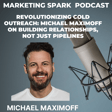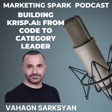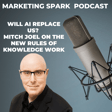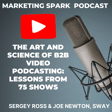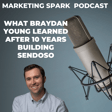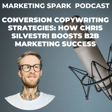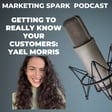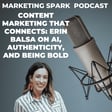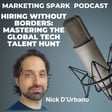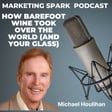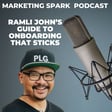Become a Creator today!Start creating today - Share your story with the world!
Start for free
00:00:00
00:00:01

Transforming Customer Service with AI: Landbot's CEO Jiaqi Pan Shares Insights and Strategies
In this episode of Marketing Spark, host Mark Evans talks with Jiaqi Pan, co-founder and CEO of Landbot, an AI-powered platform revolutionizing customer service.
Jiaqi shares Landbot’s journey from a B2C service to a leading B2B SaaS solution.
Topics include recognizing unsustainable business models, effective brand positioning, and balancing AI with human interaction.
Jiaqi offers valuable advice for B2B SaaS entrepreneurs and discusses metrics for measuring AI-driven customer service success.
Tune in for practical insights into leveraging AI, driving leads, and enhancing customer experience.
Connect with Jiaqi on LinkedIn and learn more about Landbot at landbot.io
Transcript
Introduction & Guest Overview
00:00:08
Speaker
Welcome to the Marketing Spark Podcast. Today, I'm excited to talk with Jackie Pan, the co-founder and CEO of Lambot, an AI-powered platform that helps businesses create and deploy conversational chatbots. As AI continues to have a huge impact on a growing number of industries, we're seeing a significant transformation in customer service with AI chatbots leading the charge. Today, Jackie and I will explore how these advanced chatbots reshape customer interactions, making support more efficient and personalized. And Landbot has carved out a distinctive position in this competitive landscape, leveraging innovative technology to deliver exceptional customer experience. Join us as we explore the evolving world of AI-driven customer service and discover how Landbot is leading this exciting change. Before we get started, I should mention that Landbot sponsors the podcast. Welcome to Marketing Spar, Jackie.
00:01:00
Speaker
Thanks for inviting me, Mark.
Landbot's Evolution from B2C to B2B
00:01:02
Speaker
I like to start my podcast with the backstory, the origin story, trying to discover what motivates, what inspires entrepreneurs. What is the story behind the founding of Landbot? our stories and because we did a huge pivot when we started. In the beginning, we were actually a B2C consumer service business, right? We essentially helped other businesses, ah sorry, other users
00:01:30
Speaker
to get things done online. We are like a personal assistant, but with actual human behind the scenes, talking to people and then chatting with them. The unique value proposition of and our consumer model was that all the interactions were happening over a chat. Right, so it was like quite conversational and people can right away go to us, come to us and then chat and in getting their request done, right? People are coming to us to say, hey, move me this trip or I need to do some errands. Can you help me to do that? I need to buy stuff. Can you go to search it and buy it for me?
00:02:09
Speaker
And with that, we started just having a lot of customers coming to ask any sort of things. And we started building a lot of the technology, usually just to help us to improve our own customer operations. But over time, we started to see that.
Pivoting Due to Cost Challenges
00:02:25
Speaker
the technology we have built was so powerful that it's not only interesting for us to use it, but can also potentially help other businesses in their way of communicating with customers. Then we also realized that the business model for the personal assistant service was not very scalable because we end up having to hire a lot of human agents and having a lot of people
00:02:50
Speaker
to just assist all our customers in having those chats. Obviously, we had a lot of automation already in place, but human name was always needed at some point. What was the point in which you realized that this model, this business that you were excited about and had grown, wasn't going to work either from a financial perspective or in terms of scaling the business? Was there ah where is there a straw that broke the camel's back? Was there a moment in time when the senior executive team said, we're excited about what we're doing. We've got a lot of users, but this is not a business. This is not ah a business that's gonna be successful financially.
00:03:29
Speaker
quite interesting question. It was basically when I was starting to prepare for a new round, new financing round, and start gathering a little bit the data on how the business was performing. And and I saw a graph, which was like mainly the thing that made us feel it. The graph was basically a combination of how our costs was evolving and how our income or revenue was growing right and there was basically a graph of a divergence where the cost is growing essentially exponentially the revenue is growing like more linearly and that was what makes me understanding that in order for that business to still
00:04:11
Speaker
We either have to raise hundreds of millions of revenue dollars to finance the whole operation, or it was impossible to to grow it, and which is why we ended up pivoting. That's what became Lambo today. So at that time, I'm talking about the beginning of 2017, maybe. Chatbot was suddenly becoming big because Mark Zuckerberg was announced that they want to revolutionize the world with chatbots. That was like when chatbot become popular for the first time or when the term chatbot was first used. And we had ah obviously a really good fit with that because we built this ah amazing customer communication technology.
00:04:55
Speaker
and had a lot of automation already in that. So we rapidly positioned us as a chatbot solution. But unlike most of the solution that was available in the market, we went with a very intuitive and ease of use approach, which at that time, nobody worked the term. No code was not even a thing yet. right But that was our main value proposition. So we wanted to ah help, essentially, business users non-technical users to able to have the capability to build their own bots to automate their customer journey without relying on those technical users.
00:05:33
Speaker
As an entrepreneur, failure, whether it's technical failure or financial failure is often seen as a negative.
Entrepreneurial Advice on Identifying Market Needs
00:05:40
Speaker
In this case, you built a business, you grew the business, but recognize that the model wasn't gonna work for a variety of reasons. Looking back at your experience and the journey that you've gone through, what kind of advice would you give to entrepreneurs who are looking to start their own B2B SaaS companies? Many entrepreneurs, Have a problem discover a problem recognize an opportunity and there's a lot of enthusiasm because these days relatively speaking it's easy to build a product. The tough part is obviously attracting customers and.
00:06:17
Speaker
establishing a business so when you look back at your own experience and some of the ideas and hypothesis that you had for the original business what lessons did you learn and what are some of the biggest pieces of advice that you would give to entrepreneurs looking to jump into the b2b sass world. My advice would be applicable to both B2B SaaS or any other type of businesses. And I think you mentioned one of the key piece, which is identify the problem, right? That's the first step. I think the problem many people or many entrepreneurs has.
00:06:53
Speaker
is that they are starting with the solution in mind. They they they fell in love with an idea. right Hey, I want to build this solution because I find it cool or it's interesting. right and Many times they suddenly realize that's a solution, but they don't have a clear market. They don't even know who they can sell that solution to. And then you fell into the trap of having a solution in search for a market, which is usually the best, the poor way to approach it building a business. So the first advice is trying to have a very clear idea, who is your target customer, right? What is the paying they have? And very importantly, what makes your solution be better? Because if we are talking about the B2B SaaS space, truth be told, there is thousands, if not tens of thousands
00:07:45
Speaker
of that solution is available today, and many of them excellent, right? Very good solutions. How can you convince your potential customers to choose your solution instead of whatever is the status quo and what is already on the market, right? I'm not saying that you have to be 10X better, that's bullshit, but at least you need to have some sort of angle to go to those potential customers and tell them, hey, use me because of XYZ. It's interesting that you mentioned brand positioning because obviously, and we'll talk about this later in in the conversation, because obviously it's important to differentiate at yourself from the dozens if not hundreds of companies that block and talk just like you.
Pricing Strategy & Market Positioning
00:08:31
Speaker
I did want to ask you about another pillar when looking to
00:08:38
Speaker
launch a B2B SaaS company. And that is, yes, solve a problem that people want to tackle. But the other thing is that you have to discover if whether people want to pay for your product. And when you look at your own journey, how did you get a better understanding of the fact that what you were building people would actually pay for. Were customers telling you that they would pay for it? Was it an idea that you hoped would work? What were some of the signals that you got? I'll tell you what we did and then i tell I will tell you also what we should have done. What we did is we just look at the market, what are some of the comparable product and then we try to put a pricing very similar to them. It's just pretty percent cheaper. That's what we did. okay But I think what we should have done right and that works ah relatively well in the sense of we immediately start getting
00:09:35
Speaker
people paying us and there was relatively low friction, so to speak. But I think what we should have done is doing a proper customer discovery and then understanding what is really the value of our solution representing for the customer. like For all SaaS products, especially in the B2B space, like you are solving a business problem and that business problem usually a has certain value either in terms of cost saving right what is amount of cost you're saving for that business or revenue increase like how much additional revenue can you help the business to generate and once you find that value you can identify it right then the price comes to what part of that value can you charge and usually the recommendation is either that's a
00:10:25
Speaker
a tenth of the cost right or tenth of the revenue you can create so people can get 10x the the ROY so to speak some other times and may maybe it's not that much you can get also 5x which is also great but that's usually the better way to approach pricing conversations because otherwise you will fail into the pricing war or who is end up being the cheapest price of the cheapest solution in the market. And you always have people coming to you saying you are expensive, right? Because you don't have an inquiry or you don't have a reference of what is the value of what solution is for that. I suspect that you've been working with AI for a while and one of the realities of AI is it's not new.
AI Evolution in Landbot's Technology
00:11:13
Speaker
It's a technology that has been around yeah arguably for 50 years and many companies have embraced it long before it became the best thing since sliced bread. In your experience, how has AI technology evolved since you first launched the company that was a predecessor to Landbot and Landbot itself and how has it influenced your product development? Yeah, I would say it has evolved drastically and it it has going through different stages. Like when we first launched Lambot and we made that pivot, the it didnt AI technology that was more important for chatbot was a natural language processing, NLP. and That was a technology that was ah trying to identify the pattern of how people are communicating, what are the, some of the keywords they are using, and then try to provide some sort of a categorization to say, Hey, the intent of the user is they want to know about your price. The intent of the user is that they want to know what is the integration you offer, whatever possible categorization you can give.
00:12:24
Speaker
and then you try to provide certain type of structure response to them. <unk>s That's how the previous technology works. The problem of that technology is that first, it's very hard to map out all the intents because people can say the same thing in a millions way different and million different ways, and which makes it very easy to fail and failing means the bot doesn't understand what the user is saying and one of the typical jokes we always have in the industry is like you have a bot coming and then the people say how can I help you then the user say I only speak Spanish please and the bot is using that as the what the user is needing and then they say hey Spanish please
00:13:09
Speaker
how can I further help you, whatever. So it's basically misunderstanding whatever the user is saying all the way. Then what the next evolution came is the large language models, which is really the technology behind Chagibiti, right? With large language models, the benefit you have is that don't you no longer need to map out any intent, right? Because it has such a large dataset behind all the models that it understands every intent in the market but it can have hallucination which is the problem with this new technology meaning although it understands all the intent or whatever people are saying it can sometimes misinterpret or say things that is just not true
00:13:56
Speaker
And therefore you have in precision in the way how the bot respond back to you. And then depending on the use case, this can be more or less ah damaging to the business. right So what we are seeing right now is that a lot of businesses, they are trying to have a hybrid approach. especially when the businesses have a certain scale and have a certain volume of customer interaction where they cannot permit or they cannot allow the bot hallucinating and saying some false information to the customers.
00:14:30
Speaker
so For very sensitive topics, are typically pricing-related product information, things like that, they will try to have the bot using what we call the NLP part or like the standard linear flows. And then for information that is not a a critical, right they can have the bot using the large language mouth to answer it um and which provide more flexibility and better user experience because you always understand what the user is saying.
Integrating AI and Human Interactions in Customer Service
00:15:02
Speaker
A couple of questions from that explanation. How do you address concerns about AI and automation potentially reducing the need for human customer service agents? And the second would be
00:15:15
Speaker
What strategies do you recommend for companies looking to implement AI chatbots without compromising their customer service quality? Because obviously, technology is amazing. A lot of companies definitely want to leverage the power of AI, especially for customer service and the ability to do it at scale. in a very productive and cost efficient way. But at the same time, there's many brands that have products that are complex or sensitive. As you say,
00:15:47
Speaker
Maybe a hybrid approach is the optimal way to go. The question to you is, obviously, yeah it would be one, what's that balance between human powered customer service and AI powered customer service? What are the strategies that that companies should be exploring when they're ready to take the leap into AI powered chatbots? There is a different way to look at this. First on the risk of AI replacing humans. It's um the same risk of every new technology when they are coming out. right When cars came out, those horsemen, they are in risk of losing their jobs right by replace with this new technology. Whenever this new technology is being adopted massively in the in the economy,
00:16:37
Speaker
it will open up new opportunities for people. right And that's the way we are looking at it. We don't know yet what are the potential ways this technology can help us to unlock new opportunities, but it will for sure having more opportunities and then allowing people to do probably more interesting type of work. right Because frankly, a lot of human agents, the type of task they are doing today is not very satisfying nor motivating. They're just answering very repetitive questions people are coming to them or filling out the CRM or their contact center solutions, which is ah not ah really motivating to anyone.
00:17:24
Speaker
The AI is right now really focused on replacing some of those low value tasks and then enable those human agents to focus their time and energy on things that will really add value to customers and also be more motivating for them. In our own case, just talking about our customer service team. why We have a team of 10 people in our customer service team. We are improving them actively for ways to automate their work.
00:17:55
Speaker
so that they can slowly position themselves as a trusted advisor in focusing on more strategic conversation with customers, instead of just focusing on low value, repetitive questions. It does beg the question of how a company measures the success of AI driven customer service solutions and AI powered chatbots. In your view, how do they quantify the ah ROI Well, let me back up here. In your view, what are the metrics, that the signals, the outcomes that are the most important and then how do they measure the success and the ROI of implementing an AI power chatbot to support or drive their customer service?
00:18:43
Speaker
A great question. we We have to separate between input and output metrics. For the output metrics, it's usually what is the main business use, the main kind of a value the business is trying to drive, right? ah It can be when it's very focused on customer service and customer support. how much ticket the AI has able to handle without having human assistance or without having to getting humans involved. Therefore, how much time has it helped to save humans? Then obviously you try to complement that with some sort of a leading indicators or input metrics like, hey, what is the satisfaction level on on the different conversations the AI is having, right?
00:19:32
Speaker
What are the amount of emb abandonment people are having in the conversation? Meaning like and people who start having a conversation without having it completed, they start chatting with that. not the The higher the abandonment, the poorer the experience is in theory. So there's different ways to measure that. Then if the use case is very focused on sales and marketing, which is a way also, you can then see how many leads yeah say the body is able to capture or to convert. right What is the ultimate conversion rate of those leads to become two opportunities and to deal with clothes?
00:20:11
Speaker
right and then input metric can look at how many people are engaging with the bot and if that is growing or decreasing right and how does that influencing your pipeline. You can also look at from the competitive perspective which is really important in the beginning when you don't have high volume. Go randomly just choose five conversations and see what are the conversations that are happening between the bot and the user. They seem to ask relevant questions about an answer or no, they are asking just say to asking the bot to tell some jokes or totally irrelevant questions. Those are the inputs that you need to then slowly iterate your system, right? You mentioned what is the ideal ratio or balance between AI based interaction versus human based interaction. It really depends on the journey and the type of a customers you're facing.
00:21:06
Speaker
Let me give you an example, right? In our own case, we are actively using AI bots across our entire customer journey, right? And in the very initial stage where we are business quite global and we have customers all along the globe, right? The problem we have is that sometimes we can have low quality people or low quality leads, so to speak, coming from some more income regions and that we know have very low conversion rates. And probably those say are the people we don't never want to talk to your human agent because it will just waste your time and waste your business. We asked down the line on the end side of the customer journey where we have customers already converted and actively using Lambda and paying us, we have detailed managed account type of a segment.
00:21:58
Speaker
where they are the best customer category we have and they are paying the most to us. right Those type of interactions are probably predominantly human driven because we don't want to let the customer lose their relationship or lose trust in us when and we want to be very close to them. So it really depends on where in the journey you have and who is the type of customer and what is the unique economics you have from those customers that allows you to have more humans or less humans.
00:22:31
Speaker
I wanted to circle back on a topic that we touched upon earlier, something that I spend a lot of time focused on.
Adapting to Customer Feedback
00:22:38
Speaker
It's actually the the first place that I start with all my B2B SaaS ah clients and that is brand positioning and the not the ability, but the necessity to differentiate your product in ultra competitive marketplaces. To be fair, every B2B SaaS vertical is super competitive, including AI powered chat bots. Wanted to get some insight from you into the role that brand positioning has played in LAN bots
00:23:16
Speaker
business and your ability to ah attract customers. And was it something that was top of mind? Was it something that you tackled proactively? Was it something that simply evolved? Can you give me some insight into the approach that you took and some advice to other companies that may or may not recognize the importance of brand positioning as a asset or tool that underpins not only marketing, but sales, product development, HR, raising capital, and the list goes on.
00:23:51
Speaker
First, I would say the first recommendation I would give people is follow someone who I admire for positioning type of work, especially in the B2B space. she She's April Dunford, okay? So if people are not familiar with her work, she's a positioning expert, right? She has this amazing framework that allows you to understand we did a workshop with her to help us to align our positioning. And then how we are approaching it, it's all first coming from a like a very customer-centric way. Meaning like you, the first thing you try to do is with your existing customer base, right? It's probably a different way to approach it when you are just starting it, right? and And you don't have any customers. But assuming you already have some customers, even if it's just 10, whatever the number is,
00:24:43
Speaker
you go to talk to your best customers, right? ah the The top customers you have in your you know existing base, you understand who they are, what industry they are in, what sub-industry or sub-segment they are in, right? The more niche and the more tailored you can go into, the better, right? What is really the thing that they are struggling with and they are using your solution for? What are the key differentiation those customers see in your solution that makes them perceiving you being different? It's very important what they say, not what you think you are using the customer own words to come up with those ah definitions. And then finally is the category theme, which I believe
00:25:29
Speaker
It's usually for smaller players or people who just start out. Pick an existing category. Don't try to reinvent the wheel. right If chatbot is a thing already, don't go suddenly to go something like conversational, automation of conversational, whatever random stuff you have invented. Just go with chatbot and then find your niche. Find the space. where you can be unique and be relevant where you are a part of your customers. And I think that's a little bit the the way how we have reached to our current positioning. We don't have it perfect yet, right? And we are constantly just keep improving and improving it because the positioning is also dynamic, meaning like market is constantly evolving, new players come in, right? The technology is changing,
00:26:19
Speaker
like two years ago, probably all the AI part is non-relevant, but now suddenly everybody's talking about AI, so you have to factor that in and see how does that change your positioning. I think that's a little bit the framework we use. It's important to remember that positioning is not a set it and forget a kind of proposition. I love the fact that you recognize or highlighted the fact that things change, customers change, technology changes. A hot new competitor appears on the landscape and they seem to capture the imagination of customers and prospects. And as a result, you're constantly tweaking the dials. You're constantly looking for new ways to position your product in a new and interesting way. So some great insight there.
00:27:06
Speaker
the sixty four thousand dollar question that i i did want to ask you and this is something top of mind for all ceo's these days is.
Lead Generation & Sales Strategies
00:27:14
Speaker
How to drive leads in sales so so well brand positioning and strategic planning are important and they matter as long term propositions. The here and now for most CEOs, most B2B CEOs is how do I generate leads in sales? There's a balancing act between short-term needs and long-term propositions.
00:27:43
Speaker
When you look at your own marketing and sales strategies right now to drive the business forward, what are some of the the successful things that that the company has done to attract, engage and close customers in a very competitive landscape. It's the reality is that if any entrepreneur can provide some insight, I think it's you because AI is hot, chatbots are hot. But at the same time, budgets are tight. A lot of companies are prioritizing their spending on, especially on marketing. So what's working for Landbot? What's keeping the business moving forward? Any secrets that you can reveal? Or is there anything that you're just fundamentally doing day in, day out that
00:28:31
Speaker
you continue to lead into i will share more like the mistakes and the things we haven't done so right because to be honest i don't think i we have figured it out i will share what are the things we realize that doesn't work and then maybe how we are changing it first thing is not all leads are being equal and In the beginning, we thought, hey, we need more el leads. We need to just having more people. And we have this product like growth motion where most of our customers, like 80% of our customers are just being self-serve. They come to our system, they sign up, they can try it out by themselves and they can even buy just ah using credit card. And on a monthly basis, we're generating like 10,000 signups, right? 10,000 all sort of people trying out our our solution.
00:29:17
Speaker
which yeah you might think it's a great volume of people than a great volume of leads. And we have been thinking that for some time as well, but the problem is like our conversion rate is really low. We tend to get and maybe 1% or like sometimes 2% of conversion rate out of those setups. And we always struggle, hey, what's happening? Why are we not converting people more? And one thing we just realized very recently is that because of the buying intent of people. right One question we are starting to ask people in the onboarding forum and when they sign up is that what is the reason they are using number four and we soon saw that the only
00:30:00
Speaker
30% of our customer base are trying to use it for business purposes. The other 60% is either for personal use, like side project, things like that, or educational purpose, their student, professors, university, project, whatever. which are people who will never convert. So we are actually only able to convert like a third of our overall pipeline, which is ah great, but that pipeline has not grown if we see like the historical performance, which is why we need to be very careful about our acquisition strategies. One thing we are not doing well in the past is optimizing for low cost.
00:30:42
Speaker
Meaning, we were a most both of our marketing strategies these are around talking to me, doing campaigns that are cheaper and bring more volume. which Kind of a it could work for some categories, but I think in our case, it definitely is the wrong strategy because in the end, it brought us people who are just looking for free Chagipiti alternatives or right are looking for random bots that can make jokes and won't not be very serious about using it for the business. That's the problem with a lot of it the lead generation strategies business has, right? They end up optimizing for the low lower cost and lower quality of the leads. It's much better doing the opposite, which is what we are trying to do. Like we know, like when we
00:31:31
Speaker
Acquire a high quality high buying and This is really thinking clearly What is the business challenge they have and how they want to solve it with above? The the conversion rate is going through the roof and the retain all that's the unique or now economics tend to work really Okay, then what are the different ways how we are trying to acquire customers? One of the people we have a invested long time ago is content and Content marketing, to be honest lately has a lot of noise, a lot of people say with all this AI generated a content, SEO will die. It's been two years and content has still growing nicely for us and keep growing, to keep driving volume. So I don't really see the content marketing going away.
00:32:22
Speaker
But you have to be very strategic about it, right? You have to understand what is the type of keywords because in the end you you are optimizing for the search engine, right? Really the keywords that will be the type of leads that apply by intent. We don't want to just optimize for high volume keywords, but in the end, the quality is very low. right And the only way to do that, I will relate back to the messaging part, is doing customer discovery and customer interviews. right And one mistake we did, and I personally regret it quite a lot, is not doing that personally myself as the CEO or article.
00:33:05
Speaker
I'm delegating that to the team like ah the the customer facing team maybe our customer success team or our sales team and then having them bringing up the insight from the customer discussions and then us as the kind of founders or leadership we try to extract conclusions to save time right but the reality I saw is that There's so much nuances that is missing in the way when you are not hearing directly from the company. You as the founder, you have much wider perspective of what is the problem that you can solve for the customer and what is really the words they're using because those end up making huge difference, right? One advice, if I can only give one advice to people is do not skip this, right? It's hard work. It's boring.
00:33:57
Speaker
It's not giving you immediate results, but it's necessary for your business to work. Yeah. Patience is a virtue. A lot of companies and CEOs need to realize that marketing is a long-term proposition and that it's a slow burn as opposed to a sprint.
Conclusion & Contact Information
00:34:17
Speaker
This has been great. Covered a lot of ground, talked about AI, talked about content marketing, talked about brand positioning, talked about chatbots. Where can people learn more about you and Lenbot?
00:34:28
Speaker
People can always follow me on LinkedIn, and they can also visit our website, Lambo.io. Very, very appreciate you doing this session with me. Thanks, Jackie. And thanks to everyone for listening to another episode of Marketing Spark. If you enjoyed the conversation, rate it. Subscribe via Apple Podcasts, Spotify, or your favorite podcast app, and share via social media. If you're a B2B SaaS company with revenue, of $1 million to $10 million, dollars and you're looking for strategic and tactical support to scale, we should talk about how I can help you do marketing that drives outcomes. Whether you're looking for better brand positioning, lead sales, brand awareness, or simply getting key projects completed, you can reach out to me via email, mark at marketmans.ca, connect with me on LinkedIn, or visit marketingspark.co. I'll talk to you soon.


